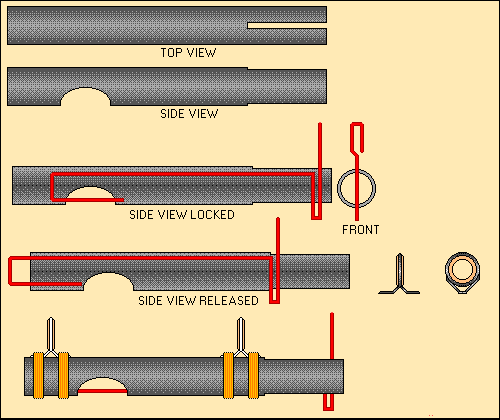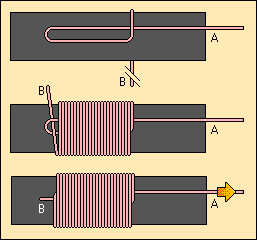
Dropping stuff
Ferries , messengers, transporters: all describe the same gizmo that's used to carry and drop loads up the line.
I've used several designs and although the winged versions are the most spectacular they do have a lot of disadvantages.
They are relatively heavy and need big wings to lift a moderate load, and if the angle of the line is to steep they won't work. Another problem I encountered many times: when the wind at ground level has another direction than the wind at kite height (and that is quite common) the messenger gets unstable and usually ends up twisted around your flying line.
That's the reason I prefer another system: not as colorful but much more reliable: also it's a lot smaller
The biggest advantage is that if your kite can support the load you can get it up. It involves a double flying line and a simple release mechanism.
A big advantage is that you determine the timing of the release: if the wind is gusty you can wait till it's calmed down a bit.
The only disadvantage I can see is that you have to use a fixed line length: you'll have to make a seperate looped line if you want to release on different heights.
The cost of a double line is hardly an issue: you need only half the strenght you normally would, and you can use cheap nylon line.
The following description is just there to demonstrate the principle: you can vary it in a lot of ways, depending on the materials available.
You start with a tube of about 2 cm diameter and 20 cm lenght: everything that's light and easy to work with will do. Cut a vertical slot in the front both on the top and the bottom.
Next stage is to file out a circular piece at the rear bottom end.

The trickiest part is to bend the (red) release wire: it has to fit snugly in the tube and has to be the right lenght (look carefully at the closed and the released position).
The rings used are line guides as used on fishing rods: they have a ceramic ring inside and slide real easy.
They are tied to the tube.
The finished transporter: notice that the loop in the wire is higher than the tied-on loops. This is because the line should not touch the top of the wire loop,even when it carries a load.

This is the way things should look if you've attached the transporter to the line. Both lines should run through the rings, and the clip should not only connect the ends of the line but also be secured to the transporter.

If you "take in" the top line the transporter will go up until it reaches the pulley near the kite. When the wire loop hits the pulley it will slide backwards and release the load.

This is the way to tie the guides to the tube. First you make a loop alongside the tube. "A" is the short end of the line. Wrap the line tightly round the tube and at the end of the wrap pull it through the loop. If "A" is pulled the "knot" is forced under the wrap. Cut off the eccessive line.
 Back to the index
Back to the index






 Back to the index
Back to the index